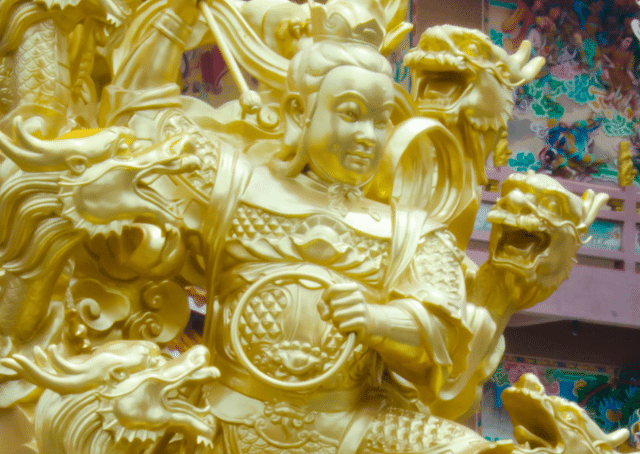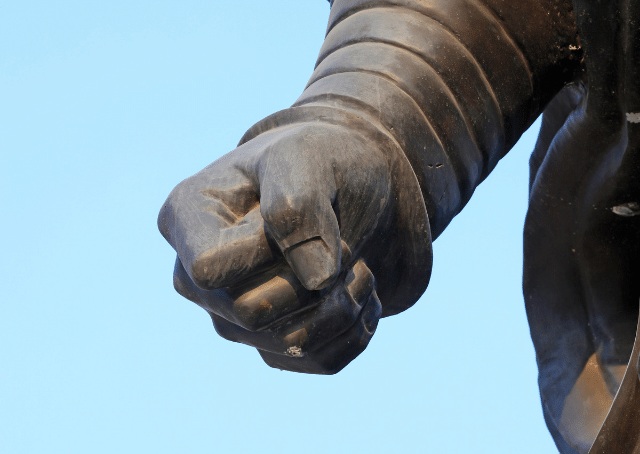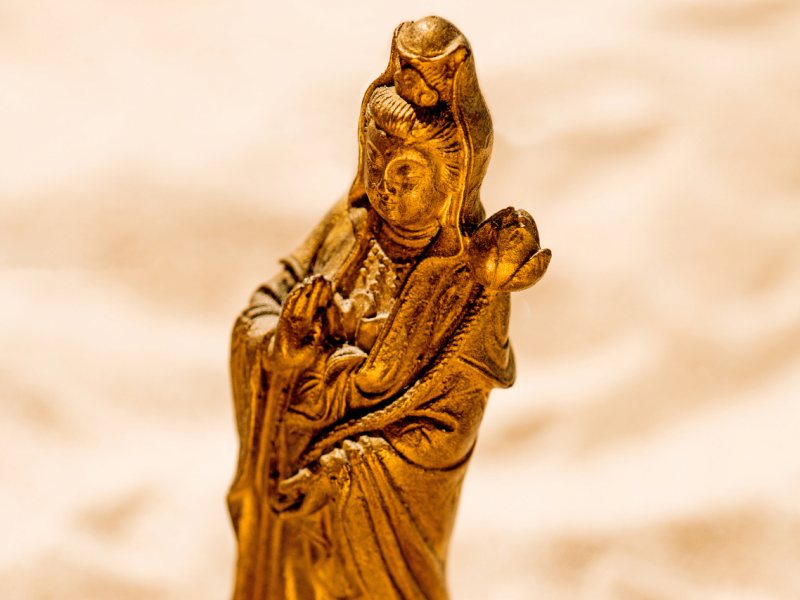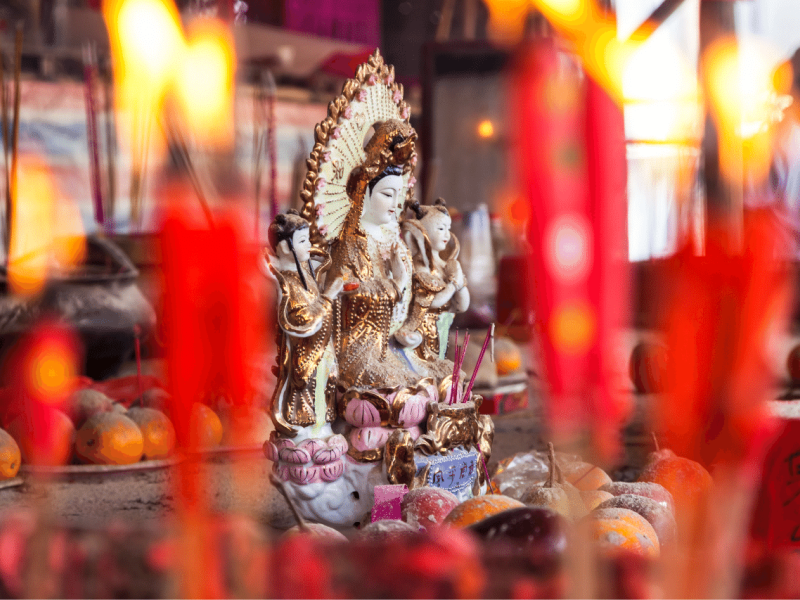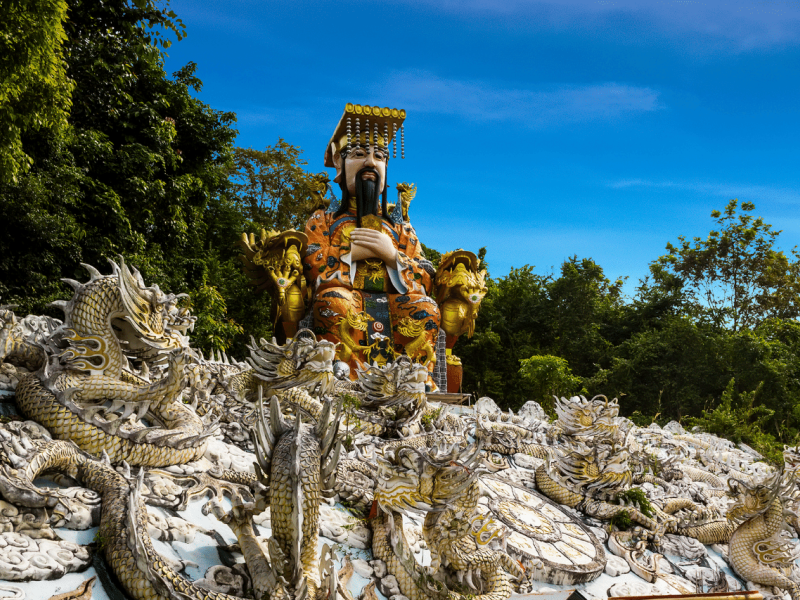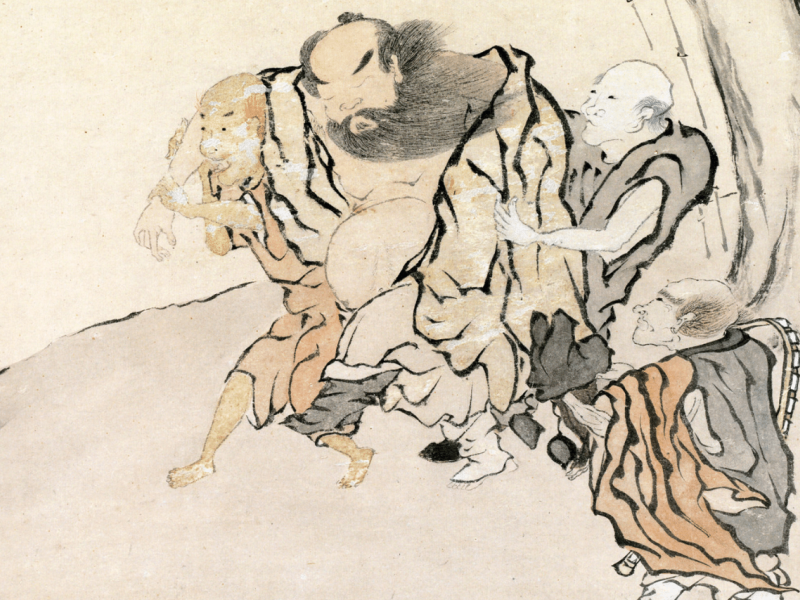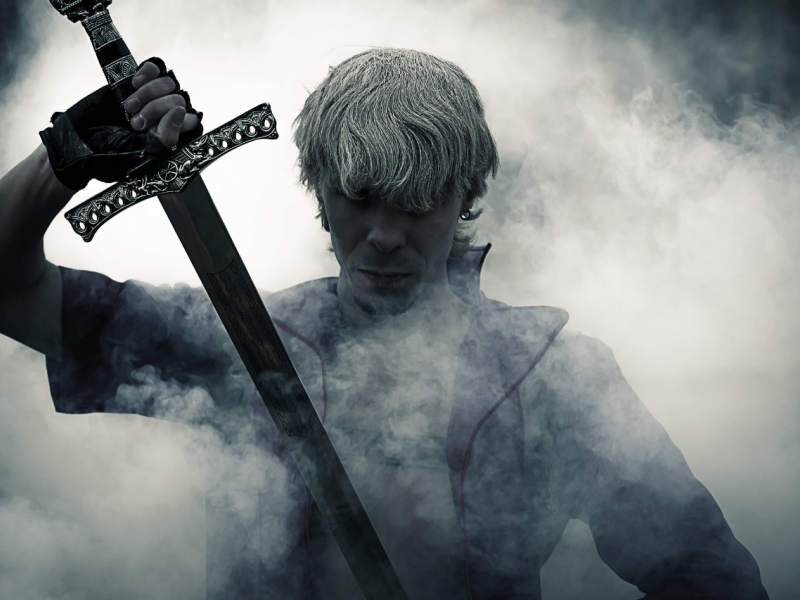Nezha
Nezha: Patron Deity of Troublemakers, Misfits, and Teenagers
In this in-depth bio, you will learn who Nezha is, his history, and the myths credited to his name.
You will also learn:
Why Nezha is worshipped as a god
The meaning of Nezha’s name
How Nezha is depicted in Chinese artwork and literature
The hidden meaning behind Xiwangmu’s name
Who is Nezha in Chinese mythology
Nezha’s origin myths
Differing versions of his exploits
How Nezha is honored today
Nezha
In Chinese mythology, Nezha is the patron deity of young adults. He is also seen as the guardian of society’s misfits and rebels, and due to his ability to move about on fiery wheels, Nezha is revered by professional race car and taxi drivers.
Name Meaning
The legend of Nezha is based off of earlier myths from India concerning the Hindu god Nalakuvara. In fact, Nezha’s name is the name for Nalakuvara, for when Nalakuvara was transliterated to Chinese it became Naluojiupoluo. As the years passed, the name was eventually shortened to Nazha, and then when romanized it became Nezha.
Appearance
In artwork and literature, Nezha is always depicted as a teenager with his hair wrapped in a warrior’s bun. In his hands he holds his Fire-Tipped Spear, and he wears Wind Fire Wheels on his feet.
Even though most of Nezha’s stories involve him fighting his father and killing his siblings, as a deity, Nezha is seen as a protector who makes sure that children respect their parents. The myths of Nezha ultimately stand as an example of the Buddhist concept of filial piety and respect for one’s family, no matter the cost.
Who is Nezha in Chinese mythology?
In Chinese mythology, Nezha is the patron god of rebellious youth and societal misfits. In Taoism, Nezha is known as the Marshal of the Central Altar. After becoming a deity, Nezha was given the official title Third Lotus Prince.
There are many variations of Nezha’s origin, with some painting Nezha as a sympathetic character, and others as a precocious and vengeful youth. All of Nezha’s origin myths feature Nezha battling with his father over perceived wrongs before eventually submitting to his elder.
The origin of Nezha
In the ancient text, The Creation of the Gods, Nezha was born the third son to a military leader named Li Jang during the Shang Dynasty. The father of Nezha, also known as the pagoda-wielding heavenly king, was married to Lady Jin, while Nezha’s older brothers were named Jinzha and Muzha.
Before his birth, Lady Yin was pregnant with Nezha for three years and six months before finally going into labor. During labor, Nezha was born as a ball of meat that crawled out of his mother. Li Jang, frightened of what seemed to be a monster emerging from his wife, grabbed a nearby sword and hacked at the ball of meat. When striking the lump of flesh, a full grown boy jumped out of the ball, bowed low, and said hello to his parents.
Li Jang and Lady Yin were completely flabbergasted witnessing the young man standing before them. Their birth attendant, a monk named Taiyi Zhenren, was not afraid, however. He said that Nezha was a blessing from the gods and that he had the superhuman strength of a deity, and the powers of the gods. Offering to take the boy under his wing as a disciple, Nezha’s uncertain parents obliged.
In another version of this myth, the birth attendant, Taiyi Zhenren, is actually an immortal that becomes the first emperor of the Shang Dynasty. According to the Fengshen Yanyi, Taiyi Zhenren helps Nezha grow into a renowned scholar and deadly martial artist who becomes Taiyi’s prized pupil.
Most scholars believe that Nezha’s origin story is based on the Hindu nature spirit Nalakubar and tales of the god Krishna. Nalakubar was a yaksha (a spirit that is usually playful and mischievous), in this case the son of the yaksha king, Kubera, and his story is found in the Ramayana.
There are many early Buddhist sutras that link Nalakubar to Nezha, as the original variant Naluojiupolua over many years changed to Naluojubaluo, then to Nazhajuwaluo, and then ultimately shortened to Nazha. When adding the character for radical to his name, Nazha became Nezha.
Killing the Dragon King’s Son
The most well-known legends of Nezha have to do with him killing the Dragon King’s son. However, there are many different variants of this myth, each painting Nezha in a slightly different light.
One of the earliest legends of Nezha killing the Dragon King’s son is found in the work The Creation of the Gods. Because of the circumstances of his birth, Nezha was a very lonely child. The stories of his birth travelled far and wide, and Nezha had no friends or companions.
One day, as Nezha was playing near the ocean shore, he noticed a boy swimming in the water. As Nezha got closer, he realized the young boy was actually a dragon, and as Nezha was lonely he asked if the boy would like to play. The dragon boy told Nezha that his name was Ao Bing and that he would like to play, so Nezha threw him his ball. As the young men frolicked in the surf, they began to play fight, and Nezha, not knowing of the power of his superhuman strength, accidentally killed Ao Bing.
Ao Bing’s father, Ao Guang, was the Dragon King of the East Sea. When finding out that Nezha had killed his son, Ao Guang was filled with fury and demanded vengeance. Ao Guang went to Li Jang and ordered that in retribution, Nezha must die. As he spoke his decree heavy rains began to fall, as the Dragon King threatened to flood the world if he was not granted his revenge.
To save the world, Nezha committed suicide, giving his bones and skin to the Dragon King as payment for his mistake. Satisfied, the Dragon King closed up the heavens and the rains ceased. Yet, Nezha was unhappy. He did not think it was fair that his young life should end because of a simple mistake, and because he could not completely cross over because the Dragon King held his flesh and bones, he had no place to rest. Nezha went to the Lady Yin in her sleep and asked his mother to construct a temple for him so he would have a place to be remembered and rest.
Waking from her dream and filled with unhappiness that Nezha was trapped in a condemned state, Lady Yin ordered that a temple be built for her son. However, Li Jang was not in agreement with his wife.
The king felt great shame for what Nezha had done and felt that Nezha had dishonored the family in killing the Dragon King’s son and for his suicide. When finding out about the temple, Li Jang took a great hammer and knocked the temple down.
Nezha challenges his father
Seeing that his father had destroyed the only thing that would give him peace, Nezha was filled with rage. Feeling sorrow for his disciple, Nezha’s former master Taiyi Zhenren desired to reincarnate his former student. Crafting a body from lotus roots, the immortal breathed life into the creation, and Nezha was reborn.
But Taiyi Zhenren was not done. Wishing to aid his former student, Taiyi gave Nezha the mythical Fire-Tipped Spear and the legendary Wind Fire Wheels so that Nezha could move at blinding speed. Armed and mobile, Nezha began to search for his father to kill him.
While outside his home, the father of Nezha saw his reborn son running towards him. Li Jang ran as quickly as he could until he found his middle son, Muzha. When seeing Muzha, Li Jang asked him to defend his father against the reborn Nezha. Wishing to honor his father, Muzha confronted his young brother and challenged him. Nezha, filled with superhuman strength and rage, struck his brother down easily, and then turned his attention to his father.
As he lifted his spear to kill Li Jang, two Buddhas appeared – Randeng Daoren and Wenshu Guangfa Tianzun. Nezha hesitated with his killing stroke, as he wondered why two of the great Buddhas had come to him. The Buddhas told Nezha that while it was unfair that he had been treated as he had, it was a violation of the Buddhist Five Precepts if he killed his father.
Remembering the teachings of his master, Nezha instead lowered his weapon and reconciled with his father, demonstrating filial piety and honor toward his parent, no matter the cost.
Nezha kills the Dragon King’s son – Taoist version
After becoming the disciple of Taiyi Zhenren, Nezha became a skilled martial artist and a gifted scholar. However, Nezha was still quite rebellious and irritated his father to no end. Nezha became known for practical jokes and for being quite mischievous.
Nezha’s father’s kingdom, Chentang Pass, was set in the same area that the Dragon King of the East held dominion over the waters. Because the dragon was fierce and cruel, the people of the kingdom were afraid to go to the Jade Emperor whenever the dragon caused flooding and other disasters.
Nezha often bathed in the streams and creeks of the kingdom. And one day, as Nezha bathed in the stream, he accidentally slipped and caused the Dragon King’s palace to tremble. Irritated by Nezha’s negligence, the Dragon King used his magic to send a drought upon the land.
To appease the Dragon King of the East, the people began to offer food sacrifices to him, but he was not assuaged of his decision. Instead, the Dragon King ordered that a boy and a girl be provided him so that he could eat them. He dispatched a servant to the kingdom to give a list of his demands to Li Jang, and to bring back a boy and a girl.
When the Dragon King’s servant appeared to make his demands, Nezha attacked him and beat him off. The servant returned to the Dragon King and begged him to send someone else in his stead. Infuriated with Nezha’s insolence, the Dragon King sent his own son, Ao Bing, to demand a sacrifice. However, due to his skill in the martial arts, Nezha easily killed the Dragon King’s son.
Upon finding out about his son’s death, the Dragon King of the East personally appeared before Li Jang. He commanded that Li Jang should offer himself as repayment, and if he did not, then the Dragon King would annihilate Chentang Pass with torrential floods.
Li Jang refused to be held responsible for Nezha’s actions. The Dragon King’s anger was now boiling over, and he exclaimed that he would kill Li Jang and all of the people of Chentang Pass. However, Nezha, seeing that everyone was about to be punished for his mistake, instead offered himself as sacrifice, giving his flesh and bones to the dragon to save his father and kingdom.
Nezha becomes a deity
Due to his sacrifice, Nezha found himself lifted to the heavens as a god. The Dragon King, seeing this, went to heaven to petition the Jade Emperor to reject Nezha and send him to Diyu for judgment. Unable to hold back his contempt for the dragon any longer, Nezha began to battle the Dragon King. Using his superior skills to beat the dragon violently, even ripping off the Dragon King’s scales, Nezha forced the Dragon King to acknowledge him as a deity before the Dragon King transformed into a tiny snake to make his escape.
After Nezha’s bones were given back to his family, Nezha appeared in his spirit form to his mother and asked her to build a temple in his honor. After doing so, the temple became famous, as many people would be healed when visiting the site. Taoists gave Nezha the title Marshal of the Central Altar and Third Lotus Prince.
Li Jing, however, was not so happy with his youngest son. He was still angry at the trouble that Nezha had caused throughout his life and could not stand that people were now honoring him. In a fit of anger, Li Jing had the temple burnt to the ground, causing Nezha’s spirit to not have a home.
Wandering homeless, Nezha went to his former master, Taiyi Zhenren, who created a new body for Nezha to possess. Nezha was also given the legendary Wind Fire Wheels and the Fire-Tipped Spear.
Calling to the gods for vengeance, Nezha began to fight his father throughout the kingdom. After many battles, Li Jin began to weaken, as he could not match the superhuman strength of his son. Knowing he would soon falter, Li Jin begged his middle child, Muzha, to face Nezha in his stead. But Nezha easily struck down his brother with his mythical spear.
Upon Li Jing finding that Muzha was dead, he sought to end his own life. However, before committing the act, Randeng Daoren appeared and used his power to capture Nezha, and then taught him that what he was doing was wrong. Nezha reconciled with his father and disappeared.
After Nezha was gone, Randen Daoren showed Li Jing how to use the Burning Golden Tower to capture Nezha if he desired to fight again. It was then that Li Jing became known as the Burning Pagoda Taoist.
Honoring Nezha today
Even now to the present day in China, parents traditionally honor Nezha by giving him offerings for their children. These gifts traditionally are given to make sure children grow up to be respectful of their family, and to honor their parents.
Nezha, deity of troublemakers and misfits
In Chinese mythology, Nezha is the patron deity of teenagers and the guardian of society’s misfits and rebels. The myths of Nezha stand as a testament to the honorable concept of filial piety and respect for one’s family, even at great cost to oneself.
The stories of Nezha are adaptations of earlier Indian myths, particularly relating to the god Nalakuvara
Nezha is often depicted as a teenager with his long hair wrapped in a warrior’s bun. In his hands he holds his Fire-Tipped Spear, and he wears Wind Fire Wheels on his feet
Most of Nezha’s myths involve him fighting his father and killing his siblings until realizing his mistake and relenting to his father’s authority
In Taoism, Nezha is known as the Marshal of the Central Altar. After becoming a deity, Nezha was given the official title Third Lotus Prince
As a deity, Nezha is seen as a protector who makes sure that children respect their parents as the myths of Nezha stand as an example of filial piety and respect for one’s family, no matter the cost.
The myth of Nezha is more than a story of sacrifice, injustice, and retribution. Nezha’s story is one of setting wrongs right and submitting to the respect for one’s elders. Honored as the patron deity of troublemakers and teens, Nezha’s blessing is still sought by many in Southeast Asia.
